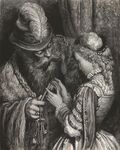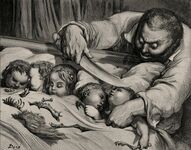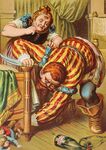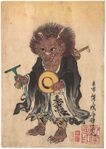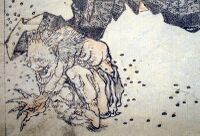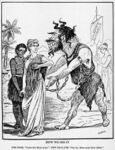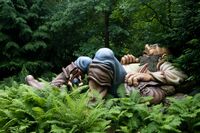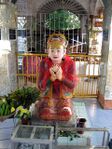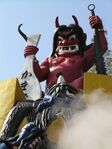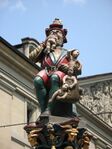Unsolved:Ogre
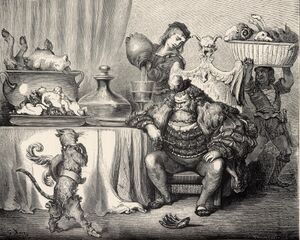
An ogre (feminine: ogress) is a legendary monster depicted as a large, hideous, man-like being that eats ordinary human beings, especially infants and children.[1] Ogres frequently feature in mythology, folklore, and fiction throughout the world. They appear in many classic works of literature, and are most often associated in fairy tales and legend.
In mythology, ogres are often depicted as inhumanly large, tall, and having a disproportionately large head, abundant hair, unusually colored skin, a voracious appetite, and a strong body. Ogres are closely linked with giants and with human cannibals in mythology. In both folklore and fiction, giants are often given ogrish traits (such as the giants in "Jack and the Beanstalk" and "Jack the Giant Killer", the Giant Despair in The Pilgrim's Progress, and the Jötunn of Norse mythology); while ogres may be given giant-like traits.
Famous examples of ogres in folklore include the ogre in "Puss in Boots" and the ogre in "Hop-o'-My-Thumb". Other characters sometimes described as ogres include the title character from "Bluebeard", the Beast from Beauty and the Beast, Humbaba from the Epic of Gilgamesh, Grendel from Beowulf, Polyphemus the Cyclops from Homer's Odyssey, the man-eating giant in "Sinbad the Sailor", the oni of Japanese folklore and the ghouls of pre-Islamic Arabian religion.
Etymology
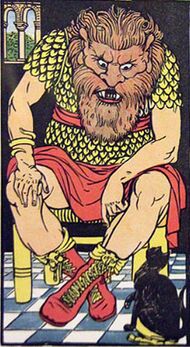
The word ogre is of French origin, originally derived from the Etruscan god Orcus, who fed on human flesh. Its earliest attestation is in Chrétien de Troyes' late 12th-century verse romance Perceval, li contes del graal, which contains the lines:
Et s'est escrit que il ert ancore
que toz li reaumes de Logres,
qui jadis fu la terre as ogres,
ert destruite par cele lance.
"And it is written that he will come again,
to all the realms of Logres,
which was formerly land of ogres,
and destroy them with that lance."
The ogres in this rhyme may refer to the ogres who were, in the pseudohistorical work History of the Kings of Britain by Geoffrey of Monmouth, the inhabitants of Britain prior to human settlement. The Italian author Giambattista Basile (1575–1632) used the related Neapolitan word uerco, or in standard Italian, orco in some of his tales. This word is documented[2] in earlier Italian works (Fazio degli Uberti, 14th century; Luigi Pulci, 15th century; Ludovico Ariosto, 15th–16th centuries) and has even older cognates with the Latin orcus and the Old English orcnēas found in Beowulf lines 112–113, which inspired J.R.R. Tolkien's Orc.[3] All these words may derive from a shared Indo-European mythological concept (as Tolkien himself speculated, as cited by Tom Shippey, The Road to Middle-earth, 45). The Dictionary of the Academy of France alternatively states that the name is derived from the word Hongrois, which means Hungarian, as of western cultures referred to Hungarians as a kind of monstrosity.[4] Ogre could possibly also derive[citation needed] from the biblical Og, last of the giants (or from the Greek river god Oiagros, father of Orpheus).
The word ogre came into wider usage in the works of Charles Perrault (1628–1703) or Marie-Catherine Jumelle de Berneville, Comtesse d' Aulnoy (1650–1705), both of whom were French authors. The first appearance of the word ogre in Perrault's work occurred in his Histoires ou Contes du temps Passé (1696). It later appeared in several of his other fairy tales, many of which were based on the Neapolitan tales of Basile. The first example of a female ogre being referred to as an ogress is found in his version of Sleeping Beauty, where it is spelled ogresse. Madame d'Aulnoy first employed the word ogre in her story L'Orangier et l'Abeille (1698), and was the first to use the word ogree to refer to the creature's offspring.
In modern fiction
In modern times, ogres have appeared in the Dungeons & Dragons role-playing game as large, powerful humanoid creatures, with slightly below average intelligence,[5]: 249, 257 [6] throughout its editions as adverseries[7][8][9][10][11][12][13][14][5] but also playable characters.[15][16][17] The ogre was counted among the ten best low-level monsters by the authors of Dungeons & Dragons for Dummies. They posit that the ogre "teaches players about fighting big, powerful, stupid monsters, which is an iconic D&D experience".[18]
The green-skinned ogre Shrek is a fictional character created by the American author William Steig that since 1990 has appeared in a book, several movies, a TV series, and a musical.
Fairy tales that feature ogres
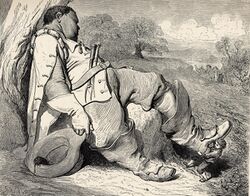
- "Bearskin"
- "The Bee and the Orange Tree"
- "Corvetto"
- "The Dove"
- "The Enchanted Doe"
- "Finette Cendron" or "Cunning Cinders"
- "The Flea"
- "Garulfo"
- "Hop-o'-My-Thumb"
- "Liisa and the Prince"
- "Mr Miacca"
- "Puss in Boots"
- "The Selfish Giant"
- "Sleeping Beauty"
- "Tale of the Ogre"
- "The Three Crowns"
- "Violet"
Gallery
In illustration
-
Giovanni Lanfranco: Norandino and Lucina Discovered by the Ogre, oil on canvas, c. 1624
-
Gustave Doré (1832–1883): Bluebeard, woodcut from an 1862 edition of Histoires ou contes du temps passé
-
Gustave Doré: Illustration for Le Petit Poucet, 1862
-
Gustave Doré: Illustration for Le Petit Poucet, 1862
-
Alexander Zick (1845–1907): Illustration for Der kleine Däumling
-
The ogre and his wife, illustration for Hop-o'-My-Thumb from a late-19th-century German fairy tale book
-
An oni in pilgrim's clothing
-
Kawanabe Kyōsai (1831–1889): An oni in wandering Buddhist priest's robes, 1864
-
Katsushika Hokusai (1760–1849): An oni being chased away by scattered beans, detail of a print
-
Political cartoon from 1900 depicting Australia as an ogre and referencing its origins as a penal colony
In sculpture
-
The ogre from Hop-o'-My-Thumb at Efteling, Netherlands
-
An ogre king represented at Mandalay Hill, Myanmar
-
The ogress Sanda Muhki represented at Mandalay Hill
-
A Japanese oni
-
An oni in Beppu, Kyushu
-
Ogre Fountain (lit. "Child Eater Fountain") at Corn House Square, Bern , Switzerland .
See also
References
- ↑ Warner, Marina. Why do Ogres Eat Babies?. SpringerLink. doi:10.1007/978-1-349-13816-6_18.
- ↑ Vocabolario Degli Accademici Della Crusca
- ↑ "Beowulf". Humanities.mcmaster.ca. http://www.humanities.mcmaster.ca/~beowulf/main.html.
- ↑ Dictionnaire de l'Académie française (1932–35)
- ↑ 5.0 5.1 Ammann, Keith (2019). The Monsters Know What They're Doing. Saga Press. ISBN 978-1982122669. https://books.google.com/books?id=Ax2zDwAAQBAJ&pg=PA8.
- ↑ Croitoriu, Michaël (May–June 1998). "Aide Au Jouer: Talents & Pouvoirs" (in fr). Backstab 9: 54.
- ↑ Gygax, Gary, and Dave Arneson. Dungeons & Dragons (3-Volume Set) (TSR, 1974)
- ↑ Gygax, Gary. Monster Manual (TSR, 1977)
- ↑ Gygax, Gary, and Dave Arneson [1974], edited by J. Eric Holmes. Dungeons & Dragons Basic Set (TSR, 1977)
- ↑ Gygax, Gary, and Dave Arneson [1974], edited by Frank Mentzer. Dungeons & Dragons Set 1: Basic Rules (TSR, 1983)
- ↑ Cook, David, et al. Monstrous Compendium Volume One (TSR, 1989)
- ↑ Slavicsek, Bill. Dungeons & Dragons Adventure Game (TSR, 1999)
- ↑ Cook, Monte, Jonathan Tweet, and Skip Williams. Monster Manual (Wizards of the Coast, 2000)
- ↑ Mearls, Mike, Stephen Schubert, and James Wyatt. Monster Manual (Wizards of the Coast, 2008)
- ↑ Slavicsek, Bill. The Complete Book of Humanoids (TSR, 1993)
- ↑ Croitoriu, Michaël (November 2000). "Dungeon Master's Guide" (in fr). Backstab (24): 74–75.
- ↑ Eckelberry, David, Rich Redman, and Jennifer Clarke Wilkes. Savage Species (Wizards of the Coast, 2003)
- ↑ Slavicsek, Bill; Baker, Rich; Grubb, Jeff (2005). Dungeons & Dragons for Dummies. Indianapolis, IN: Wiley Publishing. p. 356. ISBN 978-0-7645-8459-6. https://books.google.com/books?id=xNU7E01MCEgC&dq=ogre&pg=PA356. Retrieved 27 March 2012.
Further reading
- Briggs, Kathrine Mary. The Fairies in Tradition and Literature. London: Routledge, 2002.
- "Ogre." Encyclopædia Britannica Online. 15 May 2006, search.eb.com[|permanent dead link|dead link}}]
- Rose, Carol. Giants, Monsters, & Dragons: An Encyclopedia of Folklore, Legend, and Myth. New York: W. W. Norton & Company, 2001. Script error: No such module "CS1 identifiers".
- Shippey, Tom. The Road to Middle-earth. London: HarperCollins, 1992 (rev.). Script error: No such module "CS1 identifiers".
- South, Malcolm, ed. Mythical and Fabulous Creatures: A Source Book and Research Guide. Westport, CT: Greenwood Press, 1987. Reprint, New York: Peter Bedrick Books, 1988. Script error: No such module "CS1 identifiers".
External links
 |

